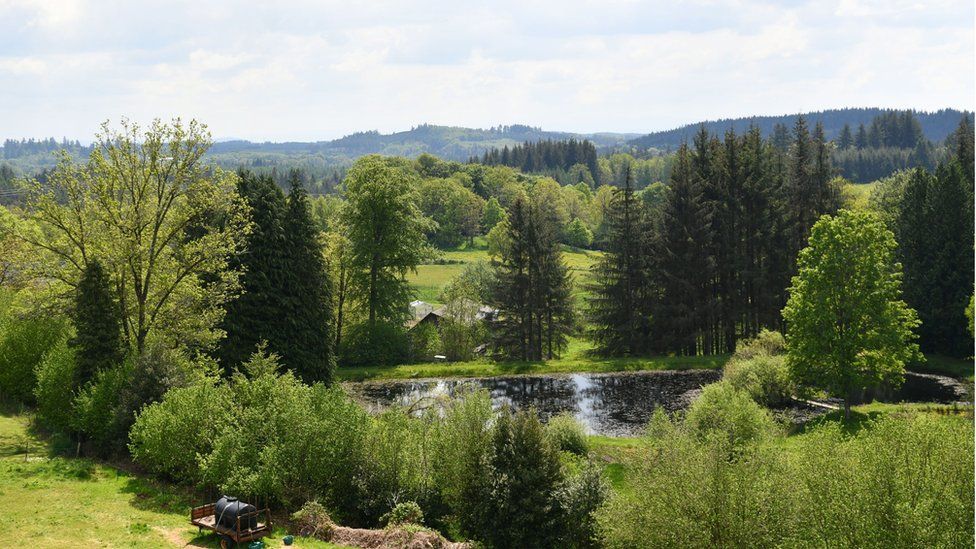2 hours ago
About sharing
Archaeologists have found evidence of a mass execution of German prisoners who were forced to dig their own graves and then shot by the French Resistance a few days after D-Day, during World War Two.
French and German teams discovered bullets and cartridges, as well as coins, at a remote site in central France identified by the last surviving witness.
After France surrendered to Hitler’s Germany in 1940, the underground Resistance movement gathered force over years of occupation and by June 1944 was poised to help the Allied invasion in Normandy.
The eight-day excavation in wooded hills near the town of Meymac failed to unearth human remains.
“The bodies are definitely there somewhere. We are not going to stop now,” said Xavier Kompa, head of the French Veterans’ Affairs Office in the Corrèze department.
Kompa was speaking at the police checkpoint at the start of the track leading to the site. The site itself remains off-limits to press and public.
The dig has been suspended, but will be resumed after more analysis of the ground and of the finds.
The search follows the recent revelations of 98-year-old former Resistance fighter Edmond Réveil, who broke nearly 80 years of silence to speak about the killings for the first time.
In an interview with the BBC, Réveil recalled the reaction of the German prisoners when they were told they were to be shot.
“They knew what was coming…. They got out their wallets and looked at (photographs of) their families. There was no crying out. They were soldiers,” he said.
“They were shot in the chest from a distance of four or five metres.”
The prisoners – 46 German soldiers and one French woman collaborator – had been ordered to dig their own graves in the form of a long trench.
Following Réveil’s account, French and German officials focused their search on a section of woods near the hamlet of Encaux. Ground-penetrating radar perceived what appeared to be a trench that fitted the description.
However when a 45- by 10-metre area was excavated, it proved fruitless. The teams then switched their attention to an adjacent zone, which had not been analysed with the radar.
In this area – not yet cleared of trees – they discovered the artefacts that apparently confirmed they were in the right place.
Twenty bullets as well as bullet-casings are of French, German, American and Swiss manufacture – which would reflect the variety of weaponry used by the Resistance.
All date from before 1944, as do five coins.
The Corrèze prefecture said that more studies would now be carried out, and “when new elements allow us to pinpoint the remains, a new effort will be made to exhume them”.
“It is extremely hard to find the exact spot, because the terrain has changed so much,” said Kompa.
“Back in 1944, this was heathland. The pine trees were planted by the Americans after the war. And the configuration of the paths has changed too.”
Réveil’s story triggered massive media interest when it was reported in May.
“We had no idea the world would focus so much attention,” said Kompa. “That’s another reason why we are going to keep looking.”
As an 18-year-old member of the Francs Tireurs et Partisans (FTP) Resistance group, Réveil had taken part in an anti-German uprising in the Corrèze capital of Tulle just after the Normandy landings of 6 June 1944.
The Normandy landings – often referred to as D-Day – saw the Allied forces of the US, UK and Canada begin an attack that lasted for 11 months. It eventually led to the defeat of Nazi Germany and the liberation of occupied Europe.
Days after D-Day, French fighters captured between 50 and 60 German soldiers. But the fighters were then forced to flee into the mountains by the arrival of German reinforcements.
In retaliation for the uprising, on 9 June the SS Das Reich division hanged 99 hostages on the streets of Tulle.
The next day they massacred 643 people in the village of Oradour-sur-Glane, which has remained an empty monument ever since.
Réveil was part of the Resistance escort moving north-east with their captives, taking mountain paths to avoid German patrols.
After three days walking, on 12 June, the commander radioed to headquarters for orders. This was when he was told to have the prisoners shot. Some Czechoslovakian and Polish nationals were spared.
Réveil says that he did not personally take part in the killing.
After the execution, a cloak of silence descended. There was a tacit oath taken by the 30 or so Resistance fighters never to mention it again.
Réveil decided to speak out only because he was the last person alive to have been a witness.
“It needs to be told. It’s been a secret long enough,” he said to the BBC.
In 1967 – in circumstances that have never been fully explained – there was actually a first excavation at the scene. This unearthed 11 bodies. But the dig seems to have been abruptly stopped, and all official records expunged.
The likely reason is that former members of the Resistance – who were still numerous and influential in French politics – did not wish the episode to be resuscitated for fear of sullying their heroic image.
According to Meymac’s mayor Philippe Brugère, such considerations are now long gone.
“The guardians of the memory of the Resistance were fearful it would harm their name. But today no-one wants to cast judgment. People understand that in war all acts become possible.
“You can be on the side of the righteous, and still carry out what is morally wrong.”
Related Topics
16 May
3 July
22 August 2020
